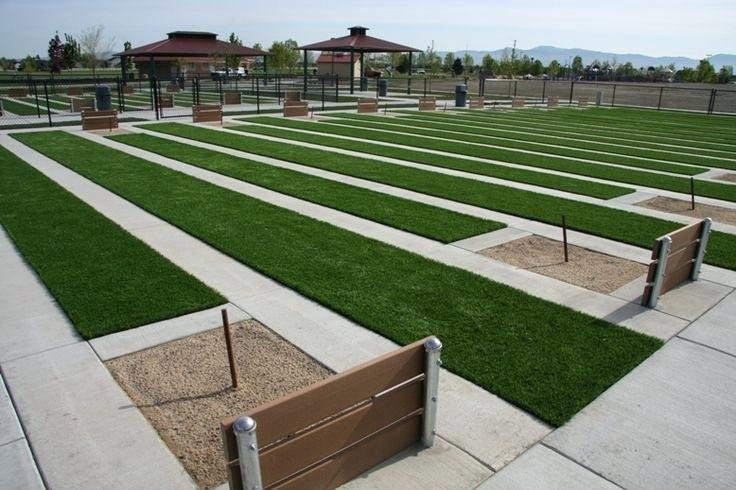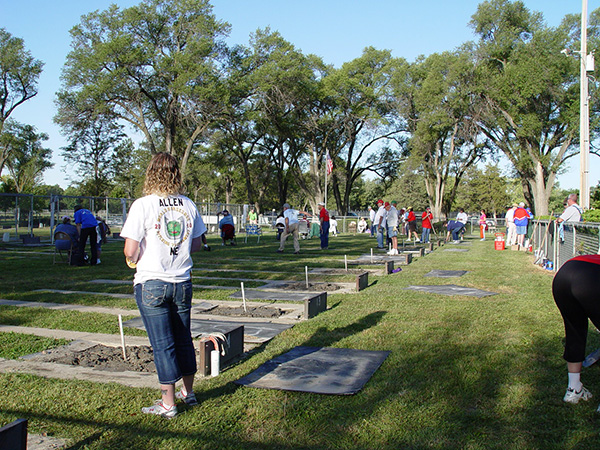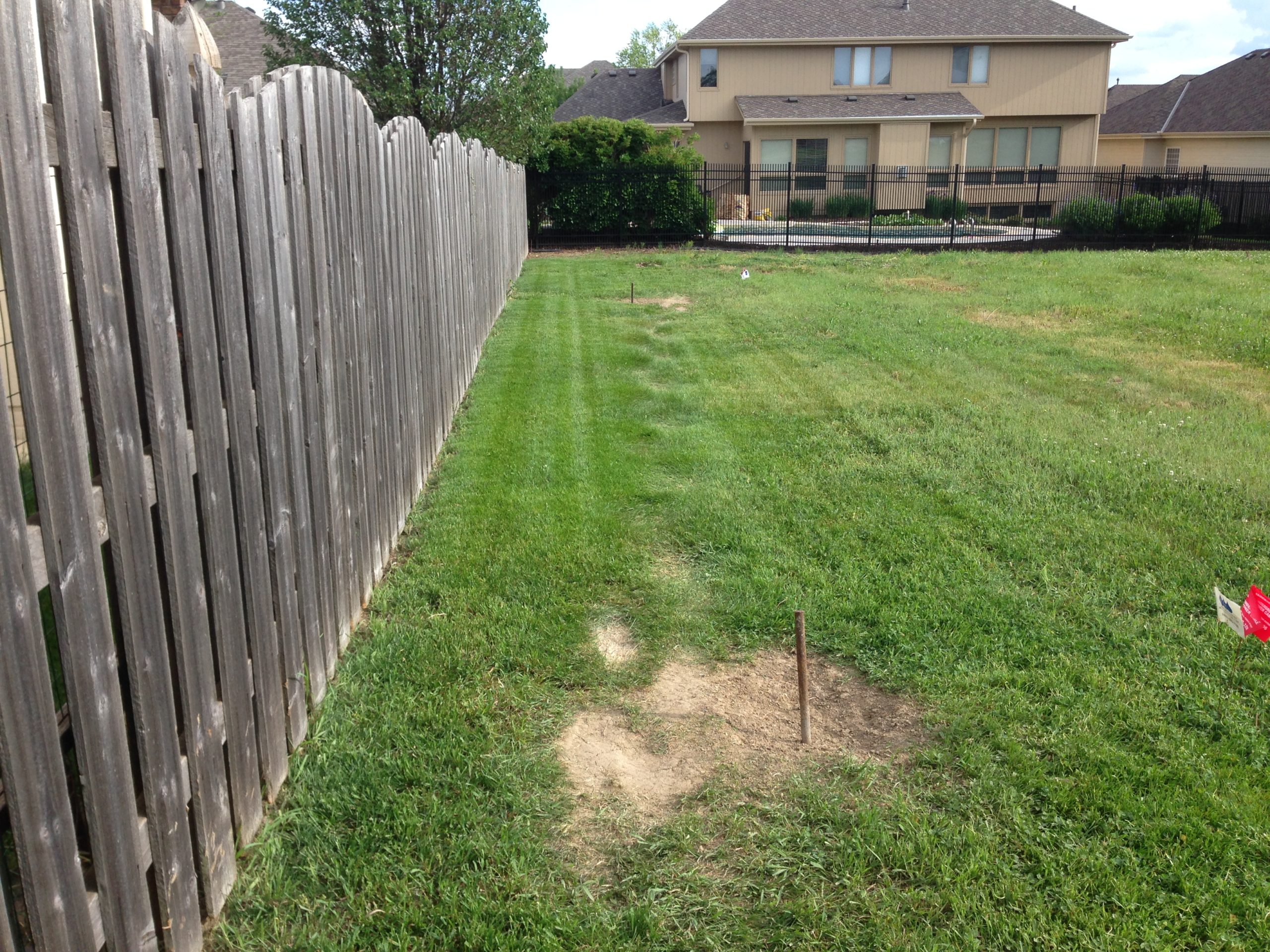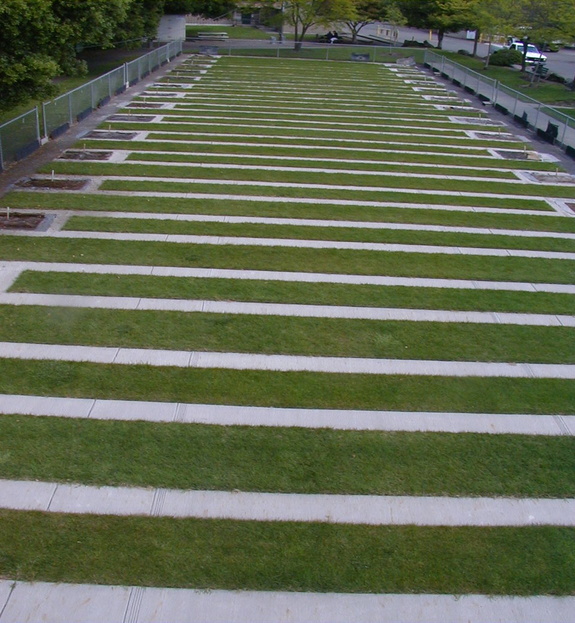Court Construction
How to:
Building Regulation Horseshoe Courts
Horseshoe pitching tournaments normally have “class” sizes of 6, 8, 10, 12 and 16 pitchers. Each “class” pitches a “round-robin” schedule where each contestant pitches one game against other in the same “class”. Thus, a 6-man class would need 3 courts; an 8-man class would need 4 courts; etc. Accordingly, court installations should be constructed with enough courts to handle the largest anticipated tournament. For example, if 40 entries were expected they could be divided into five 8-man classes requiring 20 courts. Alternately, two 8-man morning classes and three 8-man afternoon classes would require no more than 12 courts. (Suggested: minimum of 18 to 24)
See the NHPA Official Rules for details on court dimensions and specifications.
Horseshoe court lighting should be uniform over the playing surface and for a few feet outside the side lines and backstops. Outdoor lighting offers no reflective background so all light must be direct from the fixtures.
For club/tournament play, 25 to 35 footcandles is recommended, and for non-tournament play 15 to 25 footcandles is sufficient. All the surface area should be evenly lighted.
Lighting fixtures should be placed outside of all courts so that beams are generally aimed across the courts. No light sources should be located directly behind the courts or at the back corners of courts if possible. Quartz, metal halide, fluorescent, and high pressure sodium lamps are all applicable to horseshoe court lighting.
Poles should be 30 to 35 ft long, have cross arms at the top to which fixtures are attached, and be capable of withstanding at least 100-mph winds. Fluorescent fixtures should be mounted 14 to 16 ft above the court surface, outside the lines and tilted inward.
Pole mounted fluorescent fixtures may be located 22 ft above the court surface. Poles should be primed and painted a dark color. All wiring should be installed underground and outside the court area.
Basic design techniques are the same for almost any type of field.
Care of Clay & Other Pit Material
Another common material is sand. The purpose for the fill is to cushion and hold the shoe when it lands instead of letting it bounce or slide….
CLAY: Clay dries to unusual hardness, a condition certainly not conducive to good horseshoe pitching, but when kept moist and putty-like, it provides excellent service. Preparation of clay is learned by experience. Too much water will produce “slick”, a liquid solution which serves no purpose and keep the clay unmanageable. Too little water allows the clay to crack like a cookie or even harden. When suitably moist, with no trace of slick or cracking the clay will be found to be pliable and soft. Watering dry clay pits should be done by loosening the clay to 4 or 6 inch depth by shovel and adding water (leave clay around the stake for a couple inches to prevent “slick” from building up…”slick” tends to “pump” up around the stake after the clay has been watered excessively). Watering clay pits after they have been used takes only a very light sprinkling of the top surface and then shaving only the top 2 or 3 inches of clay with a shovel and turning it over, thus allowing the water to work on the underside of the clay while the next game uses the freshly turned surface of clay. This kind of maintenance after each game or practice game will keep the clay in excellent condition throughout an entire tournament. When courts are not in use, a light sprinkling and a cover to prevent evaporation and sunlight will keep the court ready for the next time it is used. Tournament directors should have shovels and sprinkler cans available and should tell pitchers if they are expected to maintain courts themselves.
SAND: Moist sand will help reduce the amount of sand knocked out of the pit by horseshoes, but under any conditions, sand filled pits usually need to be dressed nearly every inning by kicking and leveling sand with the foot, after shoes have been retrieved. Tournament directors should ask pitchers to dress their courts accordingly. Pitchers who expect to pitch in clay as well as sand during the year should be forewarned that pitches which land short of the stake and slide on for a ringer in a sand pit will not slide on clay and will remain a short shoe…a bad habit to watch out for.
WHERE TO FIND GOOD CLAY: This varies in every locality….in much of the U.S.A. good ‘blue’ clay seems to ‘grow wild’. In some areas there are local clays equally as good as ‘blue’ clay…some may even say better? Blue Clay is also known as blue shale and soapstone in some areas. The best characteristic of blue clay is that it does not build up on the horseshoe like some red clays, yet it does not leave a soapy, slippery feel (unless of course you are pitching in ‘slick’ (clay with heavy water mixture that causes thick, semi-liquid called slick). Good places to find blue clay is in excavations such as rock quarries, strip mines, building excavations, roadway cuts in hillsides, refuse dump earth excavations, etc. It may be seen along roadway cuts or in piles of strip mining overburden. It may have rock hard ‘shale’ with it which sometimes breaks down into good clay but it is usually cast aside in favor of solid-free clay. If your state does not have any blue clay (ask park departments where they get clay for tennis courts, ask local pottery and brick factories where they get clay) you may need to get it by the truck load from out of state.
OUTSTANDING BLUE CLAY FOR HORSESHOE PITS
AS A KENTUCKY BASED STONE PRODUCER,WE SELL OUR BLUE CLAY IN THE UNITED STATES. WONDERFUL COLOR, TEXTURE, DOES NOT STICK TO SHOE AND IS VERY WORKABLE. 1 800 272 0441 ASK FOR LISA OR BRUCE OR SEND EMAIL INQUIRIES TO
PTKA97@aol.com
PARTAC PEAT CORPORATION
Kelsey Park
Great Meadows, New Jersey 07838
Tel.: 800-247-BEAM (2326) ~ 908-637-4191
Fax: 908-637-8421
www.BEAMCLAY.com
Besides here in NJ, we have plants in IL, MS, TX & AZ.
Grand Ledge Public Services – City of Grand Ledge
Amy – 517- 627-2144
Grand Ledge, Michigan (Just west of Lansing)
Klawog
- Specially Formulated for Horseshoe Pits
- Resists Hollowing Out
- Eliminates Need To Turn Over Clay Between Games
- Easy to Install and Maintain
- Non-Toxic and Safe to Use
Put on a Horseshoe Clinic
How to put on a
Horseshoe Pitching CLINIC
Following the link to “Get Clinic Specifics” will take you to Dean’s website.
This outline, with your own little modifications, will give you an idea of how to go about putting on a horseshoe pitching clinic. Getting started on something seems to be the key to getting things done. This should give you a jump start on putting on that clinic that you’ve always been talking about.
This is just a suggestion of presentation material and commentary. There are probably more transparencies and commentary than what you will be able to use and still keep your audience interested. Pick out the stuff for a beginners clinic and use it for that. Pick out the stuff for a more advanced clinic and use it for that. After all, YOU will be the presenter.
PURPOSE OF CLINIC:
1. Recruit new pitchers
2. Information for those who “know it all”
3. General information for the public
4. Sign-up for league play
5. Information for those wavering on joining a club
6. Part of your Club’s Open House
7. Orientation before your club begins league play
8. Starting a new Club
9. Recreation Department Information
10. (You can add to this list.)
CLINIC PREPARATION
Determine: DATE, TIME, and PLACE to hold Clinic
If inside, have a portable court setup.
If outside, on the courts, have a presentation area with seating, electrical power, and free from the wind. You could use a building for the classroom portion and then go out to the courts for practical experience.
Clinic Staff: Chief presenter, presenter assistant, demonstrators (the “good” pitchers), registrar, fees collector, handout provider, court setup crew (all staff should wear their horseshoe pitching shirts). The chief presenter should definitely be the most informed person on horseshoe pitching “book work”.
Gather Equipment: Overhead projector, transparencies for the presentation, video player and monitor, video: Basics of Horseshoe Pitching, a fully equipped horseshoe pitching box, different brands of horseshoes, hooks, and other pitching equipment.
HANDOUTS: The least that a clinic could bring about is “free” information. Make sure people go away in hand with something about horseshoe pitching. Gather and have plenty of handouts about your local club, state association, NHPA, NHPF, where to buy horseshoes and equipment, horseshoe pitching newsletters, NHPA Newsline magazine, and whatever else you can gather and make copies of.
Refreshments and treats are always an ice breaker and gives people something to do when coming in.
Displays: You could also have a display area showing individual pitchers trophies and awards (trophies that no one sees after they are won), different brands of horseshoes, newspaper articles about horseshoe pitching, pictures, and whatever else you may think people would be interested in. Anything to peak their interest.
Advertise: Through your local recreation department, poster fliers, sending out personal postcards, newspaper articles, radio, local cable TV bulletin boards, posting on the internet, state horseshoe association newsletters, word of mouth, and you may know of other sources.
CLINIC PROCEDURE:
1. Set-up all equipment and make sure it works
2. Set-up tables for handouts, displays, horseshoes and equipment, etc.
3. Register people as they come in
4. Give them “handouts”
5. Take any fees for joining the club and leagues (have applications available for local and state organizations)
6. Make sure everyone has a place to sit or stand and to be able to see the video and overhead projector screens
7. Turn on Overhead Projector
8. (Slide 1) Welcome them to the clinic and the great game of horseshoes, etc.
9. Introduce Clinic Staff
SHOW VIDEO: Basics of Horseshoe Pitching
PROCEED with remaining set of overhead transparencies
END with demonstrations and “guests” pitching on the courts. Answer personal questions by directing them to the proper people.
Put on a Pitch & Win (County Fairs)
Contributed by Duane Goodrich
So you wanna pitch ‘shoes in your backyard with your kids or neighbor without constructing a professionally designed regulation court… Well, it is easy as planting two stakes in level ground. Measure off 40 feet and drive two 36 inch x 1 inch smooth iron rod into the ground at an angle of about 12 degrees from vertical until 14 inches remains above ground so each leans toward the opposite stake. Use a shovel to loosen the top 2 to 4 inches of soil (any deeper and the stake may not have good anchorage). A steel plate welded across the part of stake driven into the ground would help anchor the stake. Place foul lines at 27 and 37 ft from each stake…the 27 ft foul line is to be used by children up thru 18 yrs of age, women and elder men (70 yrs of age or more) and the 37 ft foul line is to be used by all other adult men. There you go….start pitching shoes.
Pretty soon you will find the stakes tend to loosen and ringers bounce off stakes when they are vertical or leaning backwards, and you find the loose soil has been knocked away by the pitched shoes. That calls for a little more work…like burying a wood log below the loose soil about 6 or 8 inches and drilling a hole at the correct angle in which to drive the stake, thus anchoring the stake better. And, maybe you decide to build a wood backboard to retain the loose soil, making it easier to kick it back around the stake.
Play with those improvements for a while…and you find the loose soil does not ‘hold’ the shoes very well. Another improvement might be to use moist sand or better yet to use moist blue clay…this will tend to hold pitched shoes where they land. Things are working pretty good now…but the pitching area is wearing rough and you want to have a hard, reasonably smooth walking surface on which to stand and pitch. Pouring narrow concrete pitching platforms is easy enuf to do, and that more or less tops off your improvements that make pitching fun.
Congratulations on your hard work. Your courts have evolved pretty much the same as they have for most everyone else. NHPA Official Playing Rules evolved the same way, thru experience…from recreational to professional design installations. Read the NHPA Rules and the court construction articles on this website before you start construction…and make your ‘evolution’ in one step. It is a great game whether you wanna pitch in your backyard or at the City Park. It can be played by one or as many people as the number of courts can handle. It is played for practice, for league play and for tournament play. Check this website for the name, address and phone number of the NHPA Regional Director in your area and find out more about horseshoe pitching activities available to you. Check out the pictures and sources for professional horseshoes too….
The required court layout for a game is two stakes fastened securely in the ground 40 feet apart. The stakes should be of iron or soft steel one inch in diameter protruding 15 inches from the ground, each leaning approximately 3 inches (12-deg. from vertical) toward the opposite stake.
Each stake is placed in the center of a “pit” measuring between 43 and 72 inches long and measuring between 31 and 36 inches wide. Moist blue clay works best as a cushion substance in the pit but other types of moist clay as well as loose dirt and sand are acceptable. On both sides of the pits are long, narrow (approx 6′ long and 18″ wide)”pitchers platforms” from which contestants are to pitch their shoes. When platforms are extended an additional 10 ft they can accomodate short distance pitchers and when extended full length on both sides of the court they provide walkways for the contestants.
The object of the game is to pitch the horseshoe so that it comes to rest encircling the stake; failing in that, it comes to rest within six inches of the stake.
“Horseshoes” manufactured for pitching (real horseshoes are not readily available or uniform in size and weight) are to be used, each weighing approximately 2-1/2 pounds and having an opening no greater than 3-1/2″. Each contestant pitches two shoes in succession.
When a contestant is pitching, the opponent shall quietly stand to the rear of or behind the other platform.
A contestant cannot start to walk to the opposite end until both players have pitched both shoes.
A shoe making contact outside the pit before it comes to rest does not count in the scoring and if it lies within scoring distance of the stake it may be removed before the next pitch by either contestant.
Foul lines shall be marked at 27 feet and 37 feet from the opposite stake across the pitching platforms. Shoes pitched by adult males must be released from the platform behind the 37 foot foul line. Shoes pitched by “elder” men, age 70 or more, may optionally be pitched from platforms behind either the 37 foot or 27 foot foul line (provided that they remain at one pitching distance and not switch back and forth) and provided that as 27 foot pitchers, they cannot pitch from behind the 37 foot foul line. Women and all youths up thru 18 years of age may pitch from any platform at any distance from behind the 27 foot foul lines. Men with physical handicap may also observe the 27 foot foul line rule.
Multiple court installations should have safety barriers or buffers to protect contestants on adjacent courts and spectators.
Scoring Rules – There are two methods of scoring: (1) Cancellation system, and (2) count-all system.
Cancellation System – Closest shoe to the stake within 6 inches scores 1 point, two shoes closer than opponent’s scores 2 points, one ringer and closest shoe of the same player scores 4 points, each uncancelled ringer scores 3 points. All equal ringers count as ties (no score). All ringers count towards total ringer percentages. A leaning shoe has no value over one lying flat touching the stake. The player that scores or ties a score receives first pitch. Most cancellation games are played to 40 points. Other point limits are acceptable if agreed upon beforehand. It is also legal to play to a pre-set shoe limit, with 40 or 50 shoes being the most popular. Ringer averages are a measure of skill and are used for “seeding” contestants in tournament play. Ringer averages are calculated by dividing total ringers pitched by total shoes pitched and multiplying the result by 100. (i.e. 25 R div by 50 S = .500 x 100 = 50.00%)
Count-All Scoring – Contestants shall receive credit for all points. The maximum is 2 ringers (6 points) and the minimum is both shoes beyond 6 inches from the stake (0 points). Count-all games are pitched to a preset shoe limit – 20, 40 or 50 shoes are popular choices.
Three Handed Game
No longer shown in NHPA Playing rules, the three handed game is still popular as a backyard activity. In three handed games,when two of the players each have a ringer and a third player no ringer, the party without a ringer is out of the scoring and other scores according to conditions pertaining if only two were in the game. Otherwise, regular cancelation rules apply.





